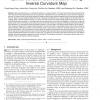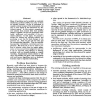246 search results - page 34 / 50 » Efficient Algorithms for Inverting Evolution |
TVCG
2008
13 years 6 months ago
2008
Mesh parameterization is a fundamental technique in computer graphics. The major goals during mesh parameterization are to minimize both the angle distortion and the area distortio...
ICPR
2000
IEEE
14 years 8 months ago
2000
IEEE
This paper presents a cooperative strategy between volumetric registration and segmentation. The segmentation method is based on the level set formalism. Starting from an initial ...
SPIRE
2000
Springer
13 years 11 months ago
2000
Springer
Biomolecular computing (BMC) aims to capture the innumerable advantages that biological molecules have gained in the course of millions of years of evolution to perform computatio...
BIB
2008
13 years 7 months ago
2008
Short tandem repeats, specifically microsatellites, are widely used genetic markers, associated with human genetic diseases, and play an important role in various regulatory mecha...
AAAI
1994
13 years 9 months ago
1994
Many AI problems can be modeled as constraint satisfaction problems (CSP), but many of them are actually dynamic: the set of constraints to consider evolves because of the environ...


